I worked with John for about 6 months. In that time, he lost 8.3 lbs. I’m sure you’re reading that and thinking, “Wait, what? Only ~8 lbs in 6 months??”
But the scale loss doesn’t tell the whole story. Look at the difference in John’s progress photos:
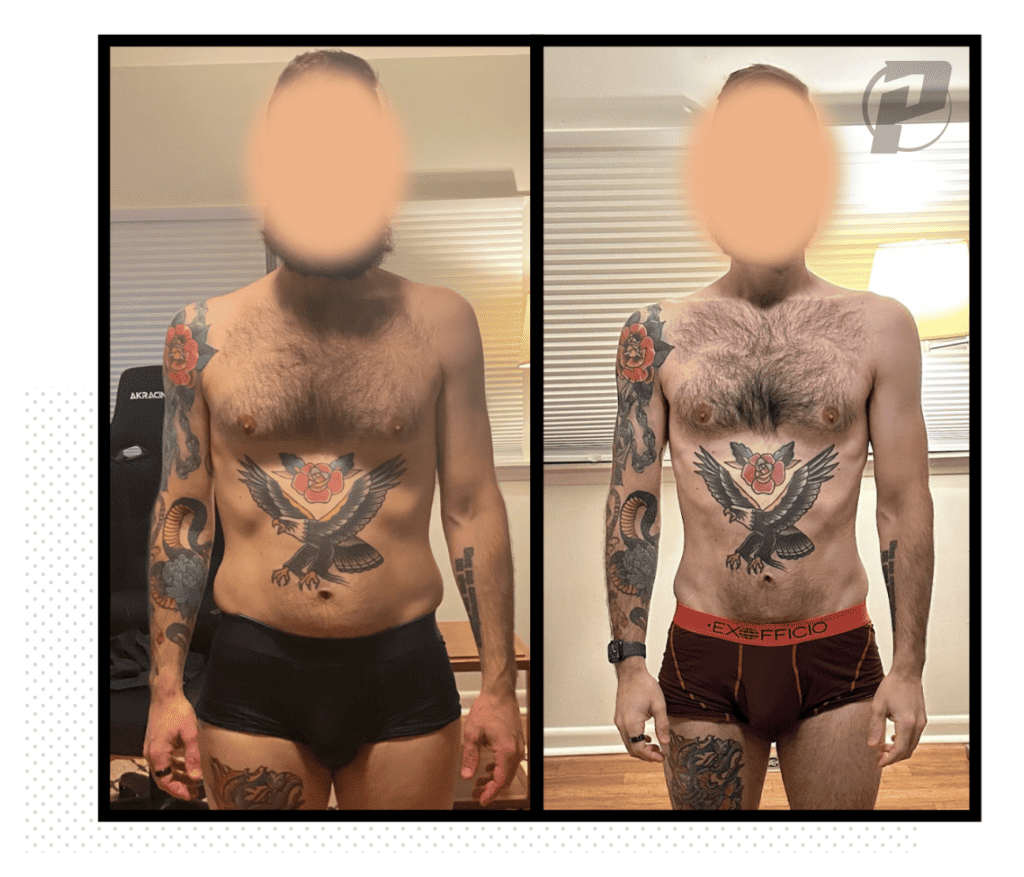
Clearly, John lost a significant amount of body fat, notably from his stomach and chest. But you can also see muscle growth in his arms/shoulders.
And if you look at the change in his weight and measurements over the 6 months–
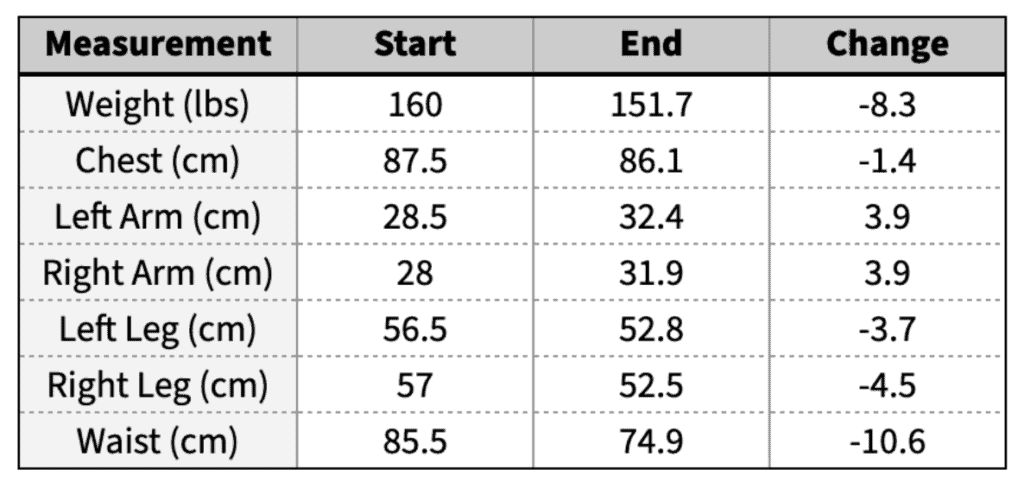
–you can see John lost 10.6 cm from his waist and increased his arm measurements. His chest and legs did lose some size. However, two things to bear in mind:
- Men hold fat in their chests, so John’s chest measurements would have decreased as he got leaner. But a -1.4 cm reduction over 6 months tells me some muscle growth happened here.
- The quads are a pretty large muscle group, so what you’re seeing here is a reflection of a decrease in muscle glycogen (and fat). John’s strength (in both the upper and lower body) continued to increase over the 6 months, and strength increases tend to correlate pretty well with muscle gain. So again, we can assume that, while the measurements showed a decrease, there was some muscle growth here too.
So the reason John “only” lost 8 lbs over 6 months was because he experienced a body recomposition – he lost fat while gaining muscle (I’ll come back to how I determined this in a sec).
It’s hard to say exactly how much muscle John gained because we never did a body composition assessment (e.g., DEXA scan), but one systematic review found untrained men gained about ~1.6kg (3.5 lbs) muscle after 10 weeks of resistance training. 1
If we assume John gained a similar amount of muscle as that study, then over 6 months, that would be 4kg (~9 lbs) of muscle gain.
While the math won’t be 100% accurate, beginners can, on average, expect to gain around 20-25 lbs (9-11 kg) of muscle in their first year of training. So the numbers I used for John aren’t that far off from what we’d expect.
Now, a body recomp is a fairly slow process. Changes are so minimal it can be hard to tell if someone’s actually recomping or if something else is going on. This leads to the question–
How did I determine John was experiencing a body recomposition?
Well, I could say I’ve been coaching for so long now that recognising these things is second nature.
While that’s true, that would be a cop-out answer and wouldn’t be useful to you reading this. Don’t worry; I’m not gonna do you like that.
There were two factors that stood out:
1. John was a complete beginner to resistance training
Before John started working with me, he was only running 3x/week. And we know that beginners can build significant amounts of muscle when they start resistance training. So from the jump, I knew John had a high potential for muscle growth.
2. John’s weight loss didn’t add up
At first, the goal wasn’t a recomp––it was fat loss. My reasoning for this was simple: John had quite a bit of fat to lose around his stomach, and while he had high potential for muscle growth, a recomp from the get-go would mean changes would happen too slowly, which could impact John’s motivation.
A deficit would make progress more tangible; seeing changes in scale weight and measurements every week would help keep John motivated.
Thus, I set up John’s diet for him to be losing between 0.5–0.7% of his total body weight per week. This worked out to around 2100-2300 kcals/day.
However, in the first week––a point in a diet where people generally see a large drop in weight as the body drops water––John had only lost ~0.4 lbs.
This isn’t uncommon.
Often, the initial calorie calculations can overestimate the client’s actual calorie needs, but there are also increases in muscle glycogen as people start resistance training.
In any case, I rarely make calorie adjustments in the first week. It’s way too early to know how progress is truly trending due to all the variables mentioned above.
But by the second week, weight loss had slowed even more – averaging about ~0.3 lbs. At this point, I made a small adjustment to John’s calorie targets (1800-2000 kcals/d).
This didn’t make a difference. John continued averaging ~0.3 lb loss/week all the way through to the end of the first month.
Now, I know what some of you might be thinking: Maybe John was misreporting his calorie intake?
If we were only tracking body weight, this would be a fair assumption.
Thankfully, we tracked scale weight, body measurements, and progress photos. When we look at John’s weight and measurement data for the first month––what do you notice?
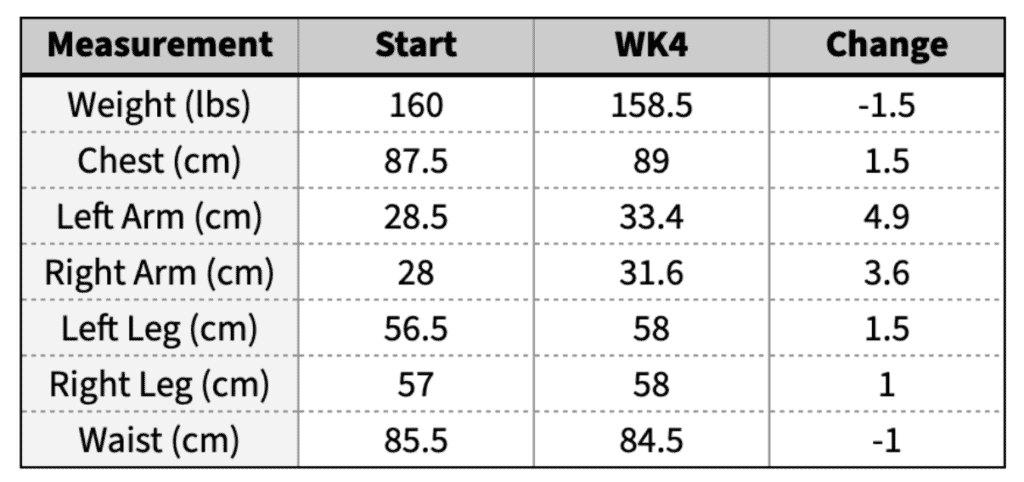
He lost 1.5 lbs (compared to the expected ~3 lbs he should have lost based on the deficit), but you can see a pretty significant increase in his chest, arm, and leg measurements, while his waist dropped by 1cm.
So looking at the above, it’s clear John was gaining muscle while dropping fat (i.e. a body recomposition was taking place).
The recomp pattern becomes even more apparent when we look at John’s weight loss graph over the coaching period:
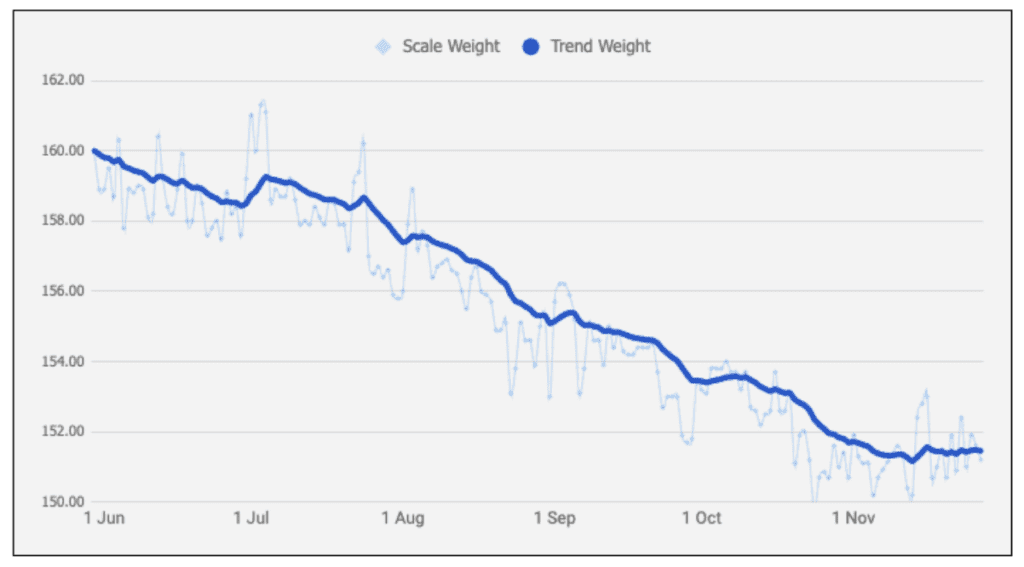
While the overall trend (dark blue line) is heading down, notice those small bumps in weight throughout the entire graph (the spikes are even more pronounced when looking at his scale weight – light blue line)? That’s another tell-tale sign of muscle growth.
At this point, I told John what was happening and explained that instead of trying to ‘force’ fat loss by cutting calories further, it would be a lot more productive to maintain a slight deficit while putting the focus on his training to take advantage of the recomp.
Once John agreed, I adjusted his intake so he was targeting a weekly loss of 0.3–0.5 %/week (or ~0.5–0.8 lbs/week).
Why 0.3-0.5%?
A smaller deficit would allow John to lose fat without impeding muscle growth. But it also meant he could eat more food which would improve training performance.
By the way, this wasn’t a random decision. A 2022 meta-analysis looked at how the magnitude of a caloric deficit impacted lean mass gains. The main finding was an energy deficit greater than 500 kcals impaired muscle growth. 2
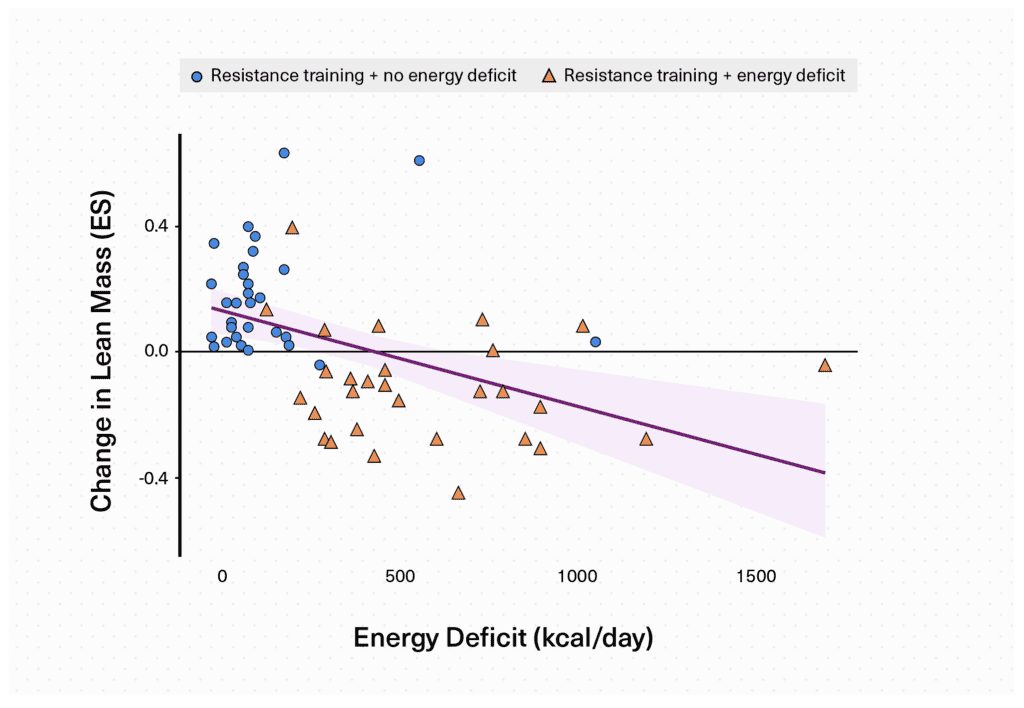
Now, there’s a lot of nuance to this finding (which I won’t get into here), but broadly speaking, the larger the deficit, the less likely you are to gain muscle during a diet.
A weekly loss of 0.3–0.5% of John’s total body weight/week worked out to a daily deficit between ~200-400 kcals. Just enough for John to continue losing fat without interfering with muscle gains.
And well, the rest, as they say, is history. In John’s words:
This has been TOTALLY transformative. I’ve never looked this good and my relationship with food and exercise have changed for the better in a sustainable way.
Throughout coaching, John enjoyed meals out, navigated social and travel commitments, but more importantly, he learned about his body and what worked for him and what didn’t.
For example, John started to enjoy resistance training, so he dropped cardio because he didn’t care it for that much.
He also went from training fasted to eating a small snack before training because he found it greatly improved his training performance.
John also had to avoid certain foods like dairy and wheat due to a chronic immune issue, but he also wanted to transition away from eating meat, so we found ways to increase his protein intake through plant-based foods and supplements.
I share John’s story because there are a few universal lessons that apply to everyone reading this.
1. Don’t only rely on the scale
The scale is only one way to gauge progress. And while it is useful, it doesn’t always give you the full story.
As you saw in this email, because we were tracking multiple data points, I was able to explain to John what was happening using his data which helped him see the bigger picture.
The main point here is that you should track your progress in more ways than just the scale.
Take measurements and progress photos at regular intervals, acknowledge the small improvements in your habits, notice how your clothes fit, changes in energy levels and mood, and increases in training performance. All of these things will give you a much better idea of progress than just the scale.
2. Stop trying to fight your body––work with it
Far too many people try to force their body into doing what they want it to do. They’ll slash calories, add in more exercise, fall for shitty fad diets or waste money on pointless supplements.
But in the end, the more you push against your body, the more it’ll push back (and biology always wins).
In John’s case, a less experienced person would have made the assumption that calories needed to be cut further based on the (seemingly) slow progress. But that would have been the wrong move (as you saw in this post).
Instead of blindly cutting calories, I continued reviewing John’s data to get a better idea of what was happening.
From there, we actually increased calories a bit to create an environment for the recomp to take place. After that, I reviewed John’s progress every week and made small adjustments to his nutrition and training programming as/when it was needed.
As a result, John could adhere to the calorie targets, hunger was manageable, and his training performance continued to increase. And, of course, he got the results he wanted.
3. The value of objectivity
You’re way too close to your own results. That emotional attachment is what causes people to make wrong decisions.
As a coach, I’m invested in your results, but I don’t let that cloud my judgement of what’s actually happening and what needs to be done.
Here’s a question for you:
If you were in John’s shoes and you were diligently adhering to your diet and training, but you only lost 1.5 lbs after a month. What would you have done?
Maybe you would have cut calories further or added in more exercise. Or, worst, quit altogether.
Now imagine if you had someone who could look at your progress and explain why things were slowing down or where you could optimise things or adjust your nutrition and training for you. Someone you could reach out to whenever you had a question or when that doubt started to creep in (versus searching Google and ending up even more confused).
That’s the real value of an experienced coach.
Sure, an intelligent training and nutrition plan is important. But the real value of a coach is getting you out of your own way so you can finally make progress.
Finally, a huge shout out to John, who absolutely crushed it and is a great example of what happens when you remain committed to the goal.
For anyone who’s reading and is interested in getting personalised training and nutrition guidance, you can check out my coaching page here to learn more and apply to work with me 1-on-1.